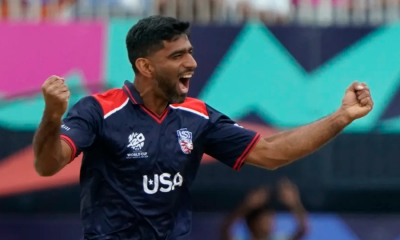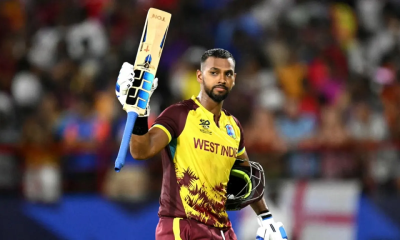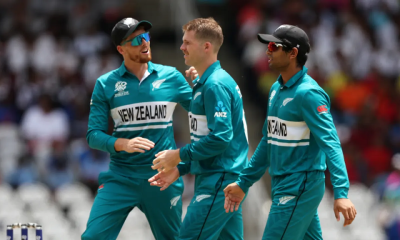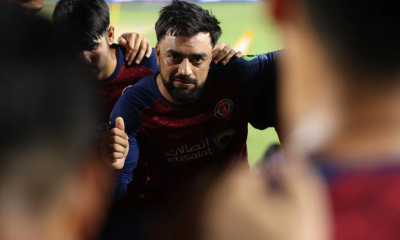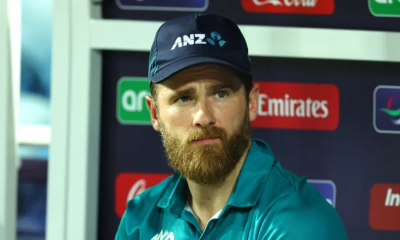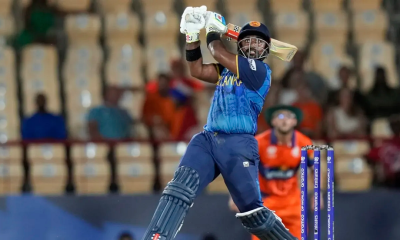Sports
England aim to revive rocky title defence against Oman
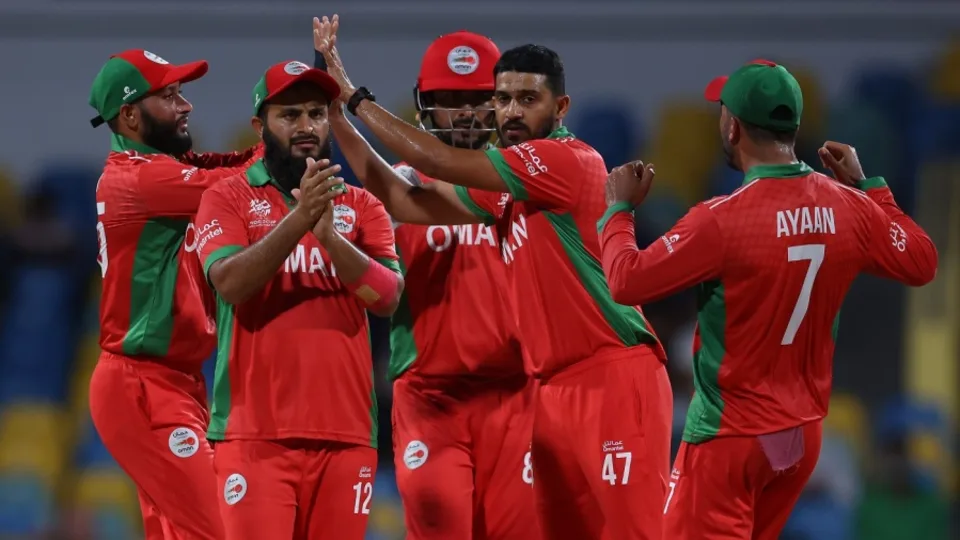
The first of a three-part fightback must start here. Before England can even indulge the unthinkable – rooting for Australia to take down Scotland by a sizeable enough margin to grant them sheepish passage into the Super Eights – they must hold up their end of this monkey-paw deal with NRR-boosting victories over Oman and Namibia. Simple enough in the spreadsheets.
That Oman come first on today [13] is welcome. Three games in, they look a team on the wane, one stretched to their limits after two solid showings. A valiant Super Over defeat to Namibia and a solid start with the ball against Australia gave way to a listless display against Scotland.
The 19th-ranked team in the world are currently number one as far as drops go – a total of eight putting them bottom on the catching front in the T20 World Cup. Captain Aqib Ilyas also lamented the number of dot balls faced on Sunday, which resulted in a score of 150 for 7, which Scotland knocked off with seven wickets and all of 6.5 overs to spare.
Form does not quite go out the window for their meeting with England, no matter how much introspection the defending champions have indulged since Saturday’s defeat to Australia. And it is Oman’s tentativeness with the bat that will give Jos Buttler’s bowlers the belief they can make amends for two less-than-convincing outings.
Buttler has put on a cheerier front this week, discarding the sterner visage he had adopted at the start of the T20 World Cup. ICC competitions demand a lot from captains when it comes to media engagements, and Buttler’s lack of enthusiasm for such duties is nothing new. So, it is fair to assume his new tact is an attempt to channel more favourable chi.
The proximity to the 2023 ODI World Cup failure makes comparisons unavoidable, and the inability to call an audible in the field against Australia speaks to similar errors in planning. David Warner and Travis Head kiboshed a prepared plan of straight lines and length from the quicks, peppering the short boundary early on. Only Jofra Archer had the wherewithal – and skill – to make adjustments, leaning on cutters to emerge relatively unscathed with an economy rate of seven. The gut feel on Will Jacks for the second over was probably indigestion.
That Australia’s pace attack took cues from Archer means analysing England’s one batting innings in two weeks is a little pointless. The collective 77 from 66 balls managed by batters three to seven was far from ideal, but understandable given the pace-off, Adam Zampa-led squeeze after Buttler and Phil Salt’s opening stand of 73. Nevertheless, improvements need to be made by the individuals – particularly Jonny Bairstow, who struck 7 from 12 deliveries before tamely hoicking one in the air – by any means necessary.
There is a sense, however, that this group – even those, like Bairstow, who were on deck for last winter’s debacle in India – have their heads well and truly in the game. Their 2022 success was ultimately forged by a similar fightback following defeat to Ireland and a washout against Australia. Though there is a little less in their control this time around, they will look to emerge from the corner for what will be a defining four days for this iteration of English white-ball cricket.
Part of the criticism Bairstow copped for his innings in Barbados was fuelled by the “demotion” of Harry Brook to number six. Moeen Ali’s floating role – which is set to continue – saw him come in ahead of Brook, who eventually got to the crease upon Moeen’s dismissal with 74 to get in just 26 deliveries. The Yorkshire wunderkind could only manage 20 from 16.
Brook has never batted higher than four in T20I cricket, and he’s only done that six times in 29 knocks. Getting him into an innings early makes sense, and No.4 seems a prime spot for him in this line-up. Whether that means dropping Bairstow down the order or altogether – unlikely for now – it feels a necessary play to ensure Brook is not wasted. It is worth noting that both times Brook has faced more than 30 deliveries, he has pocketed half-centuries at strike rates of 231.42 (against Pakistan in 2022) and 186.11 (against New Zealand in 2023).
Aqib Ilyas was refreshingly honest after the defeat against Scotland. But it is time for the Oman captain to contribute. Three innings at first drop have reaped just 34 runs from 25 deliveries, all of which have come in the first six overs. He did at least practice the positivity he preached in his last innings, striking 16 off five before being trapped lbw by Safyaan Sharif.
His party trick of bowling offspin to left-handers and leg breaks to right-handers has been effective enough. He started economically across the first two matches at Bridgetown, particularly with his 0 for 18 from four overs against Australia. But there was a rude awakening at the Sir Vivian Richards Stadium when his three overs were taken for 41.
Reece Topley is likely to be brought in for his first appearance of the tournament to add some much-needed dimension to England’s bowling attack. If that is the case, it will be for Chris Jordan, with the understanding that England are set to continue with dual pace-threat of Mark Wood and Jofra Archer. The temptation to draft in Ben Duckett to add a left-hander to the XI, at the expense of Bairstow, has been resisted for now.
England (probable): Phil Salt, Jos Buttler (capt & wk), Will Jacks, Jonny Bairstow, Harry Brook, Liam Livingstone, Moeen Ali, Jofra Archer . Mark Wood, Adil Rashid, Reece Topley
Oman need a refresh of their batting after a series of costly false starts. Their lead batter Ayaan Khan, with 92 runs at an average of 46.00, has been operating at six but is surely due for a promotion.
Oman (probable): Pratik Athavale (wk), Naseem Khushi, Aqib Ilyas (capt), Zeeshan Maqsood, Ayaan Khan, Rafiullah, Mohammad Nadeem, Mehran Khan, Fayyaz Butt, Samay Shrivastava, Bilal Khan
[Cricinfo]
Sports
Lankan legends, Modi and the Jaffna dream
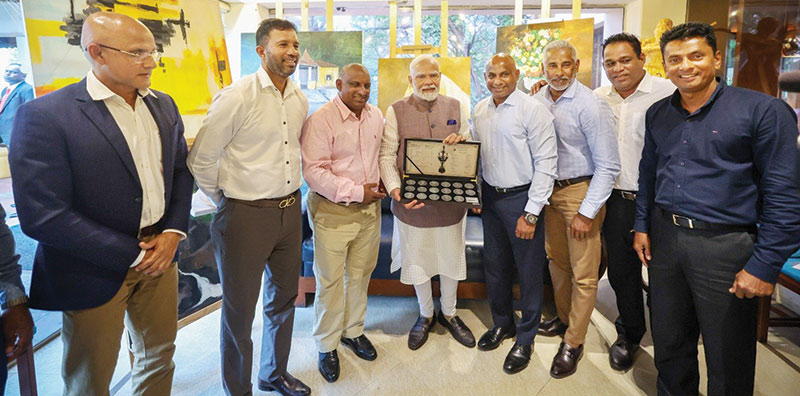
Tamil Members of Parliament with roots across the Palk Strait are often quick to look towards India at the drop of a hat. But last week, all they managed was a photo op with Indian Prime Minister Narendra Modi – smiles, handshakes and little else. In contrast, Sri Lanka’s 1996 World Cup-winning cricket team was granted a 45-minute chinwag over tea with the Indian leader. The Indian High Commission in Colombo had arranged the meeting. Not even former President Ranil Wickremesinghe, with all his so-called diplomatic finesse, has managed to get a similar audience.
Pictures of Modi rubbing shoulders with Sanath Jayasuriya and Aravinda de Silva went viral in India on social media and it was the talking point across news channels and print media as well. And why not? Not since the marauding days of Sir Vivian Richards have Indian bowlers been sent on a leather hunt quite like they were by these two Sri Lankan giants. It was déjà vu for Indian fans – memories of the Wills World Cup semi-final at Eden Gardens, still fresh like an old wound that refuses to heal.
During the meeting, Jayasuriya pitched an idea to the Indian PM – seeking help to build a cricket stadium in Jaffna. It wasn’t a doosra out of nowhere. There’s a deep and genuine passion for cricket in the north. Some of the school big matches in the region have stood the test of time, with legacies stretching back over a century. Yet, due to decades of conflict, the region has remained a barren patch in terms of producing top-tier cricketing talent.
Since the guns fell silent, though, there’s been a fresh crop of hopefuls from the north. Leading the charge is leg-spinner Vijayakanth Viyaskanth – a name that’s now turning heads. Though his First-Class stats are more than decent, Viyaskanth has chosen the glitz and glamour of franchise cricket, where the pay cheques are fatter and the schedule less grueling.
Behind the scenes, Sri Lanka Cricket’s (SLC) District and Provincial coaches have done a stellar job, scouting and grooming pace bowlers and other youngsters from these long-neglected areas. Some of these boys have gone on to wear the Under-19 jersey with pride – a sign that the talent pool is slowly, but surely, filling up.
However, SLC’s grand vision of building new stadiums to attract larger crowds has hit a few bumps. The old guard – some former greats – have been quick to swing the bat in criticism. They’ve taken their eye off the ball, failing to see the bigger picture. Take next year’s T20 World Cup, for instance. Co-hosted by Sri Lanka and India, it promises to be a blockbuster. The high-voltage India – Pakistan clash is set to take place in Colombo, with the R. Premadasa Stadium’s 35,000 seats expected to vanish like isso vade at the Galle Face green. A bigger venue – like the proposed facility in Homagama – would have been just the ticket to meet such mammoth demand.
But Sanath’s plea is in a different league altogether. He’s not asking for a behemoth like Eden Gardens or the Narendra Modi Stadium in Ahmedabad. His is a humble request – a ground with decent infrastructure and floodlights that can host day-night matches. A facility like that would be a game-changer for the north, a true shot in the arm. Nothing ignites a young cricketer’s imagination more than watching their heroes up close, not through a television screen but under the stars, in their own backyard.
At present, the closest international venue to Jaffna is in Dambulla—hardly accessible, especially for aspiring fans and players from the peninsula. A ground in Jaffna would not only bridge that distance but also build a bridge of hope and opportunity.
Back in 2002, when Janashakthi opened a branch in Jaffna, the great Muttiah Muralitharan made the long road trip to play a friendly match on a matting wicket. The welcome he received was nothing short of electric. The crowd adored him, showering him with affection that could rival the warmth of any southern stand.
Since then, we’ve hardly scratched the surface when it comes to understanding the region’s cricketing appetite. If the Indian government lends an ear to Sanath’s appeal, we might just discover a goldmine of talent waiting to be unearthed in the north. Who knows? The next Murali or Malinga might be bowling on a dusty street in Jaffna this very moment – waiting for a stage, a spotlight, and a bit of help from across the Palk Strait.
by Rex Clementine
Sports
Sri Sumangala’s cricketing miracle
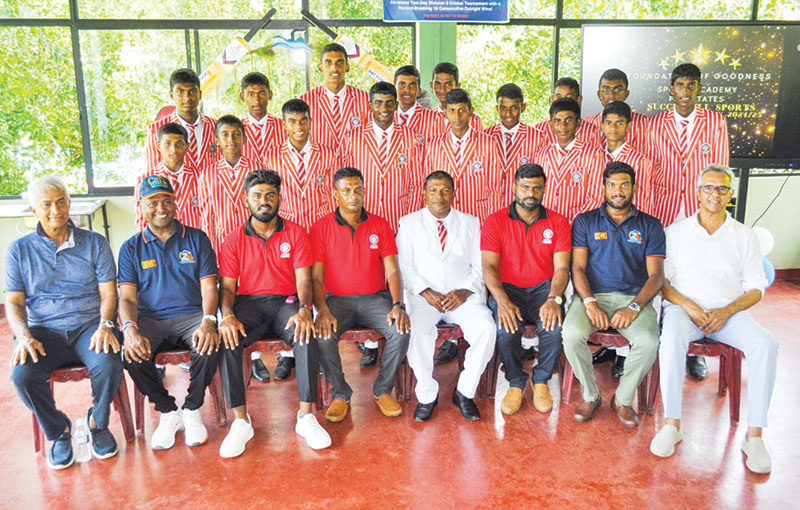
Sri Sumangala Vidyalaya, Hikkaduwa has scripted a fairytale rise in school cricket, marking a monumental milestone just 18 years after forming its first team. Once deprived of even a proper ground, the school now proudly boasts an unbeaten Under-19 team that has clinched both the Division III two-day and one-day championships — a rare double that has earned them promotion to Division 2.
The turnaround began in 2007 when the Marylebone Cricket Club (MCC) helped establish the Sri Sumangala MCC Lord’s Cricket Grounds following the devastating tsunami. This facility, offered free of charge, became a beacon for young cricketers who had talent but lacked opportunity. What followed is nothing short of a sporting miracle: 16 consecutive outright wins by the U19 team and national recognition in school cricket circuits.
This isn’t just a story of trophies and titles — it’s about breaking generational barriers. These young cricketers, once trapped in a cycle of poverty and obscurity, now inspire their community and set benchmarks for others in rural Sri Lanka.
The MCC’s early investment has borne fruit, turning dreams into tangible success. Today, the legacy of Lord’s lives not only in London but also in the hearts of the aspiring cricketers of Hikkaduwa — proof that when given a chance, talent can indeed take flight.
Foundation of Goodness has been a beacon of hope for sporting talents in the region and representation for Sri Lanka Women’s Under-19 team has been dominated by them. The same could happen with the men’s team in the near future.
Sports
St. Sebastian’s back on the basketball track
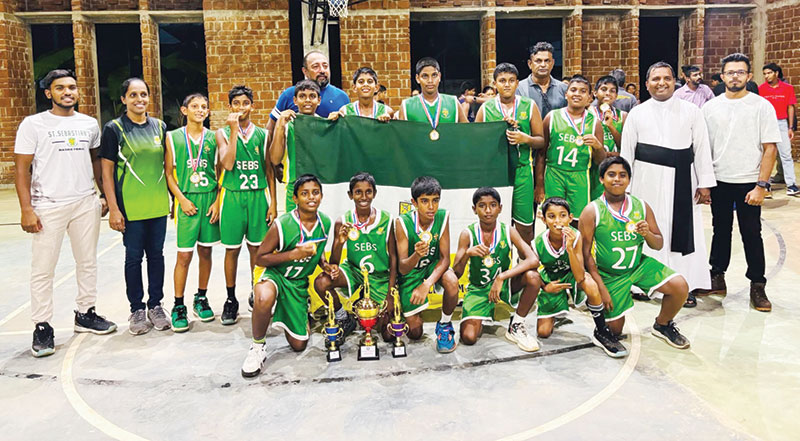
In the bygone years it was the Colombo schools that dominated basketball in Sri Lanka. Bens under Ram Sunderalingam, Peterites coached by Naufer Mahroof and the Josephians shaped by Mahadevan were the trojans who won tournaments. Led by this trio and flanked by other basketball playing schools in the capital, the game had its foundation laid down in concrete – Colombo style.
Moratuwa and Batticaloa were the painful thorns amidst the Colombo teams when it came to championships. And Trinco was the dark horse, almost unbeatable in their heyday, playing under the wizard, late Father Eugene Herbert. This is what basketball was, beginning from the sixties.
Today the faded memories remain. On a lucky day one might meet Doc Thurai, as he was popularly known, walking his wards with the stethoscope round his neck. He was the best we saw in that era. If one visits Batticaloa there is a prominent statue outside the town. It is of a tall Jesuit Priest. Here, he cradles a Wilson basketball ready to take a ‘time-out’ and yell at the referee. That is Father Herbert, the man who filled the Eastern Province with stellar players who left their luminous mark in the basketball courts of Sri Lanka.
More recently in April, on the 6th Sunday, I watched the under 13 ‘B’ division basketball finals between St. Sebastian’s and St. Thomas’ Prep. It was played at a flood-lit indoor court in Moratuwa. No, it certainly wasn’t in the league of Madison Square Garden, but it was more than adequate for a schools’ final. I sat on a wooden bench and watched the match thanking the court creator Sugath Thevarapperuma. I must mention this former national player who is doing yeomen service to promote basketball by establishing indoor courts in different locations.
Back to the match. It was good and exciting and the Sebastians won 37-36 by a solitary point. This was great for Moratuwa and the school and the young players. This victory would awaken the school and the basketballers from the doldrums they had been mired for a considerable time to say ;we are coming back’.
This 1-point victory I witnessed appeared to me as a catalyst for greater performances and perhaps an eye-opener for the Moratuwa lads. They are indeed capable of leaping bigger steps to reach higher pedestals in schools’ basketball championships. Yes, that is an achievable possibility, and the need is to change gears and go for the over-drive.
It is time for St Sebastian’s to forget the apathetic era and the reasons for such, and forge ahead with renewed motivation to re-claim former glories with their current potential.
The Thomians fought to the end. They certainly were equal in spirit and determination to become the champions. The difference was simply 1 solitary point. The pattern of play was the same by both teams and the award for the best player went to Akash Wijesinghe and Amantha Hettiarachchi was adjudged the best guard.
I noticed that some new rules have been introduced to control the game. The teams are only allowed to play ‘man-to-man’ and they could do so only from the center line. Additionally, the coach cannot use a double guard on the opposing best player. The teams are not allowed to use a zonal defense or play a floating man to man. If these rules came from FIBA then there is no argument. But if it is a local ramification of rules of how the game should be played, I have to humbly say that this will be a significant deterrent to coaches and players and a recurring headache to the referees. Over to you Sir, the Head of the Schools’ Basketball Association.
For me personally, it was an ‘Alma Mater delight’ to notice that the two coaches of the playing teams were both from St Sebastians and the assistant coach too was from my old school. Chaminda de Alwis and Susil Dias coached St. Sebastian’s and Isuru Perera the Thomians.
Chaminda captained the national team and Isuru had Ceylon Basketball colours and Susil represented All Island Schools.
Yes, St. Sebastian’s had a lot of glory days in basketball. Many of their players represented and captained the national team. Then one might ask, “how come they hit rock bottom playing a game they more or less dominated?”
The answer is simple, I will leave it for another day to elaborate.
On second thoughts, some things are best left unsaid.
by Capt. Elmo Jayawardena
elmojay1@gmail.com
-

 Business7 days ago
Business7 days agoColombo Coffee wins coveted management awards
-

 News2 days ago
News2 days agoSuspect injured in police shooting hospitalised
-

 Features3 days ago
Features3 days agoRobbers and Wreckers
-

 Features5 days ago
Features5 days agoSri Lanka’s Foreign Policy amid Geopolitical Transformations: 1990-2024 – Part III
-

 Midweek Review5 days ago
Midweek Review5 days agoInequality is killing the Middle Class
-

 Features7 days ago
Features7 days agoSri Lanka’s Foreign Policy amid Geopolitical Transformations: 1990-2024 – Part I
-

 Business2 days ago
Business2 days agoSanjiv Hulugalle appointed CEO and General Manager of Cinnamon Life at City of Dreams Sri Lanka
-

 Features6 days ago
Features6 days agoA brighter future …


